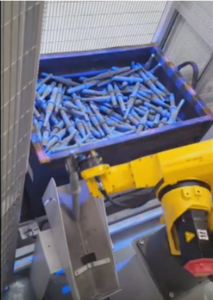ROBOTIC GUIDANCE FOR PRIMARY TREES BIN PICKING
An automotive supplier automates the automatic feeding of raw foundry primary trees to a spinning press for the production of splines. The aim of this automation is to improve on-site production processes which were previously fed manually.
In this automation application with automatic bin picking, there were many challenges to face:
- Cycle time of one part every 17 seconds on the production line
- When deposing the part, the part orientation is fundamental in order to be inserted on the footprint of the press. We had to work on the gripping configurations, and on the gripper.
- Thanks to our software eyesberg3D by VISIO NERF, it is possible to check by simulation if the tools design allows an access to all the parts in bulk, wherever they are in the bin.
The bin picking solution developed and installed is composed of a high resolution with structured light projection 3D sensor, the cirrus3D by VISIO NERF and its integrated software eyesberg3D. This 3D vision sensor is associated to a robot FANUC M-20iA (6 axis).
Part localization for the automated picking by the robot is done with a comparison between the cloud of points acquired with the 3D vision system and the CAD model of the part. The gripping system is designed to allow several gripping configurations in order to increase the number of pickable part solutions. A mechanical system has been added to make sure to deposit the part all in the same configuration in the press footprint. Collaboration robot-vision allows making this bin picking application working and automated.
THE RESULTS
The solution implemented allows production on the basis of factory operation in 3×8 with a number of parts produced per day of 4,800.
The installation makes it possible to work on all the parts guaranteeing its operation whatever the surface of the part, its position, the position of the container.
Furthermore, this 3D vision system is able to acquire a high quality point cloud on different types of materials. The system is robust to the color and shine of the part. The system is robust to the color and shine of the part.
In addition, the sensor is designed to allow simultaneous acquisition on the same scene with various materials which are not identical.
Finally, the return on investment of the end customer is calculated in six months. The operator gain is calculated on the basis of a cell operating in 3×8. Indeed, it should be noted that for this kind of application, the loading operation requires in all cases a robot and a mechanical assembly (buffer type) on which the operator places the parts to allow the robot to pick it up. The operator gain + buffer cost compared to the use of 3D vision for bin picking gives a RoI of 6 months.
The application has been done by Valente for Walor.
You can discover the video on our Youtube channel.

THE VISIO NERF TECHNOLOGY :
The experience acquired by VISIO NERF teams for almost 30 years allows them to always offer innovative and productive solutions, combining robot and vision, mechanics, process control, information and vision.
Our 3D vision solutions, optical sorting, inspection, egg candling, 3D camera for inspection, pick and place on conveyor, automatic racking system offer reliable answers to your problems. They also provide industry proven applications.
The VISIO NERF 3D camera is based on the principle of stereoscopy: use of 2 high resolution cameras with a pattern projection for the acquisition of a point cloud of unequaled quality and fidelity. Its patented software features guarantee a quality system that meets your industrial needs.
VISIO NERF is now settled in 5 countries: France, Germany, Spain, United States and China. Subsidiaries are opened to always stay closer to our clients and provide high quality products and services.
For more information, contact us !

